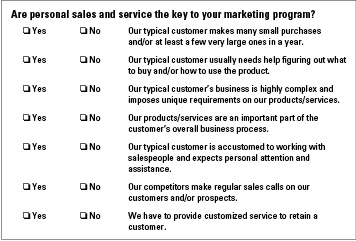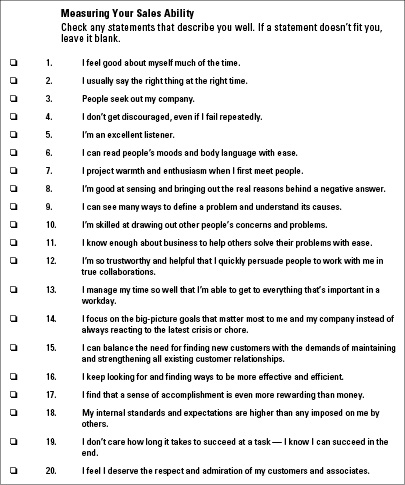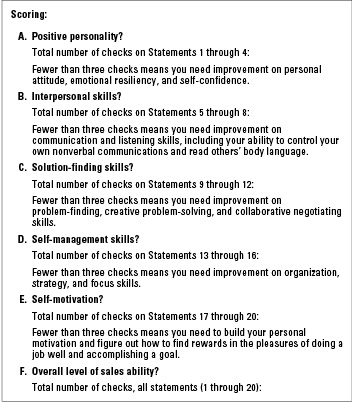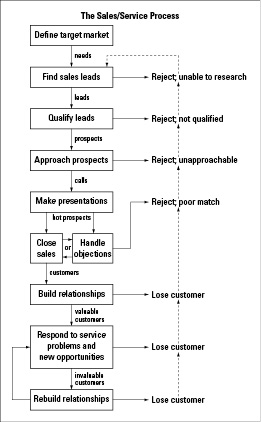Chapter 17
Succeeding in Sales and Service
In This Chapter
Designing your sales program
Evaluating sales talent
Managing the sales and service process
Organizing and compensating sales staff
Practicing great service and recovering unhappy customers
The whole point of marketing is to make a sale. In fact, the whole point of business is to make a sale. Nothing else can happen without that. But do you need to be doing personal sales and service that involves interacting with people directly as part of your marketing? The answer is always yes. Whether or not you have a formal sales role, selling should be a natural, everyday part of business life — something you do whether you’re interacting with clients, ringing sales at a register, meeting other professionals, or taking a phone call.
Knowing When to Emphasize Personal Selling
How do you know whether you need personal selling — that is, selling face to face — as part of your marketing process? To find out whether your business should rely on sales, take the following sales-needs quiz.

If you gave one or more “yes” answer to the questions in the sales-needs quiz, you can probably use personal sales effectively. If you gave three or more “yes” answers, then you definitely should consider making it an important part of your marketing plan and budget, along with good follow-up service. Although you certainly also want to use many other marketing methods, think of the rest of your marketing efforts as support for the personal sales process.
If personal selling is going to be the key to your success or failure, you need to give careful thought to how you hire, manage, organize, support, and motivate salespeople. Their performance determines whether your marketing succeeds or fails. You also need to decide whether you’ll personally play a key role in selling. Do you have the time to make sales calls and follow through on them? And do you have the inclination and talent to be a top salesperson? To find out, read the next section.
Taking Stock of Your Sales Skills
If you’re reasonably talented at selling, the more contact you have with customers and prospects, the better. If, however, you aren’t skilled at selling, then it may be a waste of your time — and your customers’ time — to have you play this role. You’d do better to hire a salesperson or use sales representatives in your place.
The following questionnaire is a simple test of your sales ability. Take five minutes to answer the questions and then another couple minutes to score them. At the end, you find some useful feedback about your overall sales ability right now and your potential sales ability — areas you need to focus on if you want to improve your score in the future.


Check out Table 17-1 to determine what your total score means.
|
Table 17-1 Figuring Out What Your Score Means |
|
|
Total Number of Checks |
Score |
|
0–5 |
Guaranteed to fail. Sorry, but you should let somebody else do the selling! |
|
6–9 |
Low sales ability. Not likely to succeed. |
|
10–12 |
Low sales ability. May become moderately capable with practice and study. |
|
13–15 |
Moderate sales ability. Capable of improvement. |
|
16–18 |
High sales ability. Will become expert with practice. |
|
19–20 |
Superstar potential! |
If you have a total of 13 or more checks, you have enough ability to be out there on the road making sales calls right now. However, this score doesn’t mean you’re perfect. If you checked fewer than 19 or 20 boxes, you should work on your weak areas — and when you do, your sales success rate should go up. (Be aware that rating yourself on such tests can be difficult and inaccurate. What do you think your customers would rate you on each item? Finding out may be useful!)
Making the Sale
To manage sales effectively, divide sales into multiple steps and focus on one step at a time as you prepare a sales plan or look for ways to improve your sales effectiveness. As with any complex process, a weak link always exists. Try to find the step in your sales process that you perform most poorly right now and work to improve it.
Figure 17-1 displays the sales and service process as a flowchart. Note that the chart doesn’t flow automatically from beginning to end. You may be forced to cycle back to an earlier stage if things go wrong. But ideally, you never lose prospects or customers forever — they just recycle into sales leads, and you can mount a new effort to win them over.
Figure 17-1: This flowchart shows you the process behind sales and service — try it!

Figure 17-1 integrates the sales and service processes. Why? Because that’s real-world selling. You can’t stop when you close a sale and write the order. Your competitors certainly don’t stop trying to win that client or account. So you need to think of a completed sale as the beginning of a relationship-building process. More sales calls, further presentations, and efforts to find new ways to serve the customer can help you retain and grow the account. The next sections delve into facets of this flowchart in more depth and help you seal the deal.
Generating sales leads
The most common weakness in sales processes is lead generation — the first and most important step. Pay close attention to how you find leads and see whether you can improve the quantity and, especially, the quality of your leads. Qualifying a lead means gathering enough information about someone (or some business) to make sure she’s appropriate. By appropriate, I mean that the prospective customer fits a profile of a good customer. What is this profile? You need to decide, based on criteria such as wealth, age, and interests (for a consumer sale), or size, industry, timing, and location (for a business sale).
Sales leads can come from any of the other marketing activities I describe in this book. In fact, I recommend you try using as many alternatives as possible so you can find out which ones work best for you. Your Web site may produce the best leads (see Chapter 10), or joining a professional group or association may help you network and meet potential clients. A direct-mail campaign may produce leads, or you may find good sales leads by using direct-response advertising (Chapter 13 covers both). Then you can consider telemarketing (also in Chapter 13), trade shows and event sponsorship (see Chapter 12), and so on. You get the idea.
1. Select a magazine, Web site, or newspaper that your potential customers are likely to read.
2. Find the smallest, cheapest display ad in that publication or on that Web site and buy ad space for the shortest possible time.
Aim for just one insertion, if you can.
3. Write a short, simple description of what you do or sell, keeping it clear and factual.
Include a clear, simple photo, if you have a relevant one (you can show the product if you’re in a product business), or use your name and logo to illustrate the ad.
4. End the ad with the following sentence: “Please contact us to find out more about our offerings by calling 800-xxx-yyyy or by using the inquiry form on our Web site at www.mywebsite.com.”
These four steps produce a basic direct-response ad designed to generate sales leads. It may or may not work very well — you always have to experiment to get your lead-producing formulas down — but it certainly gives you a start. (If you already use some good lead-generation techniques, why not test something simple in a new medium? You should always be experimenting in marketing; otherwise you may not improve.) If you get no response, try a variation and see what happens. Keep experimenting until you find a way to reliably generate inquiries from an inexpensive ad or from a key-term search on Google (see Chapter 10 for how to bid on searches and get your listing to appear).
Purchasing lists for lead generation
After you get some responses and capture their names and other information, you can call them leads. You own these leads and have the opportunity to follow up on them and see how many actually turn into customers. Good luck!
Conducting multistep lead generation
A multistep lead-generation process is one that draws possible leads from a plentiful source and then uses additional steps to identify the most promising ones and cull the rest out.
Lynden International in Seattle, Washington, used a multistep system to generate qualified sales leads for its 60 salespeople. The close ratio for sales calls improved by 70 percent after the company instituted this system. Here’s how it works:
1. Start by pulling the names of potential prospects from a database of U.S. companies called Dun & Bradstreet’s MarketPlace.
This source groups companies by SIC code (a U.S. government designation based on product type), location, and size (as indicated by annual sales) so you can target companies by industry and city and eliminate any that seem too small.
Dun & Bradstreet recently migrated and expanded this database on its Web site, www.dnb.com. Click on the Small Business button at the top of the page to find the Small Business Services division, which sells sales and marketing lists and offers services and support for your research efforts. You can get reports on firms of interest to you for a small fee. These reports include telephone numbers, addresses, the name of at least one top executive, and some financial information (such as annual sales) to help you decide whether a company makes a good prospect. Anyone doing business-to-business sales finds this resource invaluable for lead generation.
2. Call the names yourself or use a telemarketing firm (or hire a temp telemarketer) to call each of these companies.
You make this first call to find the appropriate decision-maker and ask her some basic informational or qualifying questions to see whether she uses or may have a need for what you sell.
3. Analyze the responses you get to identify prospects who should be interested in the kind of services or products you provide.
These leads, qualified by the telemarketing, now just need salespeople who can use them to set up personal meetings with the decision-makers.
The practice abuses the respondent’s trust. (And deception in sales can run afoul of fraud laws — so it may be illegal as well as unethical.)
Deceptive prospecting irritates respondents, and if it’s widely done, people stop participating in legitimate market research. That consequence, which is beginning to happen, poses a big problem for marketers.
You can also use a Web page or professional blog to reach out for prospects and generate visits and inquiries that you can turn into sales leads. See Chapter 10 for more ideas on how to use the Web to supply your salespeople with better leads. Another idea is to ask your current customers to supply you with referrals and to thank them or even reward them with gifts or discounts for the referral. Current customers can often find you good-quality leads through their personal networks.
Developing great sales presentations and consultations
At the sales presentation, the salesperson must convince the prospect to become a customer, which can be a challenge. Only a truly great sales presentation can persuade prospects to become customers at a high rate of success.
Giving emotionally intelligent sales presentations
A sales presentation that’s smart and thoughtful should cover both basic fact needs and basic feelings needs. Your presentation needs to inform while also making the prospect comfortable. Avoid sounding desperate for the sale, because doing so makes prospects uneasy. A calmly optimistic bearing is best. Present yourself well, avoid appearing messy or smelling strongly (whether of sweat or perfume), and behave in a friendly but respectful manner at all times. Avoid too much touching; give the prospect plenty of personal space. Your presence should be calming and reassuring, not stressful or anxiety producing.
Acting like a consultant rather than a salesperson
If the prospect is uncertain about what she needs, the right approach to the sales presentation is to be consultative. Start by asking thoughtful questions to figure out what the customer needs and then propose a somewhat customized solution, not just a generic purchase. Avoid rapid-fire questions. A consultative approach is good in cases where you sell complex services or products with many technical options and details.
Hitting your main points
I generally advise against a fully scripted sales presentation. Using a script makes you look like an amateur who has had to memorize her lines because she can’t be trusted to speak for herself. However, I strongly recommend that you make a bullet list of three to five main selling points and memorize this list so you can be sure to cover your main points during your sales call. Your list of main points should include the main features and benefits of the product. If you anticipate that the prospect will want to compare your offering to the competition, then include two to three reasons why yours is superior.
Showing, not telling
Even if you have a good slide show, don’t force unwilling or obviously bored prospects to sit through your formal presentation. Instead, engage them in conversation by asking questions that probe for insights into their motives and concerns. Then take a consultative sales approach.
Processing orders accurately and promptly
Responding to problems
You have to anticipate problems. Inevitably something will go wrong that will upset, disappoint, or even anger your customer. That’s why the sales process has to include a service recovery step. Make sure that the customer knows to call her salesperson when a problem occurs. If you think you can use even more help in the customer service arena, read the later section “Retaining Customers through Great Service” and then consider Customer Service For Dummies, 3rd Edition, by Karen Leland and Keith Bailey (Wiley), my additional coverage of the topic in Marketing Kit For Dummies, 3rd Edition (also from Wiley), and the free content I’ve put up for you at www.insightsformarketing.com.
The most faithful customers are the ones who’ve had a problem that you managed to solve in a fair and generous manner.
Organizing Your Sales Force
Who does what, when, and where? Such organizational questions plague many sales or marketing managers, and those questions can make a big difference to sales force productivity. Should your salespeople work out of local, regional, or national offices? Should you base them in offices where staff members provide daily support and their boss can supervise their activities closely? Or should you set them free to operate on the road, maximizing the number of calls they can make and communicating with the company through high-tech laptop computers rather than through regional offices? Or — if you have a small business — should you do all the selling, or does bringing in a salesperson on commission make sense? These decisions depend on your situation, but I can help you decide by giving you an idea of the several options available and by sharing some of the conventional wisdom that helps you assess your particular situation.
Determining how many salespeople you need
If you have an existing sales force, you can examine the performance of each territory to decide whether more salespeople can help or whether you can do with less. Are some territories rich in prospects that salespeople just don’t get to? Then consider splitting those territories. Also consider splitting — or adding a second person to create — a sales team if you’re experiencing high customer turnover in a territory. Turnover probably indicates a lack of service and follow-up visits. Alternatively, if you see some territories that have little sales potential, you may be able to merge those territories with other territories. (And if you own a small business, you should consider adding commissioned salespeople if you can’t cover all prospects adequately because of time or travel constraints.)
You can also use another, more systematic approach — which you really need when you have to design a sales force from scratch. Study your market to decide how many sales calls you want to make over a year-long period. The process isn’t very complicated, and I explain it in detail in the sidebar “How many salespeople does it take to sell a light bulb?”
Hiring your own or using reps
You have to decide whether to hire salespeople yourself or subcontract. Most industries have good sales companies that take on the job of hiring and managing salespeople for you. Called sales representatives (or just reps), they usually work for a straight commission of between 10 and 20 percent, depending on the industry and how much room you have in your pricing structure for their commission. Also, in areas where you need more work done — customer support through consultative selling and customized service — reps earn, and deserve, a higher commission.
The following sections help you figure out how to locate quality sales reps and keep them under your control.
Finding good sales reps
How do you find sales reps? The obvious doesn’t work because you can’t find them listed in most directories. I don’t know why, but rep firms prefer that you find them by networking. Doing so may avoid a lot of requests from companies that don’t know the industry and don’t have decent products. But if you want to find reps, you have to do it on the reps’ terms, which means getting word-of-mouth referrals or meeting them at a trade show or industry conference. Or, even simpler, ask the buyers of products such as the one you sell for names of reps who currently call on them.
I also highly recommend networking for reps at trade shows in your industry. Reps attend the trade shows, and many of them rent booths to represent their products. You can find them just by wandering the exhibition hall, using your eyes and nose, and asking questions.
Managing your reps — with an iron glove!
After you have reps lined up for each territory, your work has only just begun. You must — absolutely must — monitor their sales efforts on a regular basis. Which rep firms sell the best (and worst)? Usually, 10 or 15 percent of the reps make almost all of your sales. If you notice such a pattern developing, you can quickly put the others on notice. And if they don’t heat up in a hurry, you can replace them.
Renting a salesperson
Many businesses have made temps popular these days, so why not temporary salespeople? Temp agencies have been providing telemarketers on a temporary basis for years. Businesses often use those temporary telemarketers for a few weeks in conjunction with any special project that requires telephone prospecting or follow-up — such as generating leads for a new product or new territory.
Compensating Your Sales Force
You face one of the toughest and most important management decisions in marketing when you have to figure out how to compensate salespeople. Compensation has a significant impact on the sales staff’s motivation and performance, and salespeople’s performance has a big effect on sales. The issue becomes difficult because compensation’s effect on motivation isn’t always obvious.
Retaining Customers through Great Service
Sales and service go hand in hand. When your business relies on personal selling — like in many business-to-business markets and a variety of consumer markets as well — you can bet that you also need great customer service. Why? Although personal selling produces new customers, personal service keeps them. If you don’t know how to keep new customers, you shouldn’t waste your time seeking them — you’ll just lose ’em anyway. The following sections show you simple methods for keeping customers happy.
Measuring the quality of customer service
Do you know your customer turnover rate (the percent of customers who leave each year; also called a churn rate)? If your turnover goes over 5 percent in most industries, you probably have a customer service problem, and you need to build retention to lower that percentage. Find out by comparing customer lists from two consecutive years — or by asking your salespeople (if you have any) to gather the data if you can’t do so easily from your central customer database or billing records.
To figure your rate of customer turnover, follow these steps:
1. Compare last year’s and this year’s customer lists to find out how many customers you lost during the year.
Ignore new customers for this calculation.
2. Count the total number of customers on the list from the previous year.
That gives you your base, or where you started.
3. Divide the number of lost customers (from Step 1) by the total number of customers (from Step 2) to get your turnover rate.
For example, if you started the year with 1,500 customers and lost 250, your turnover rate is 250 ÷ 1,500, or nearly 17 percent. If you find yourself in that situation, you fail my 5 percent test and need to focus on improving your customer service.
Profiting from good manners
Good manners and aggressive sales don’t usually go hand in hand, but they should. Don’t assume you have to be pushy and overly assertive to maximize sales. In fact, the opposite is true: Polite sales and service personnel do far better in most cases. Emphasize being polite to prospects and customers, and keep your ear tuned to how your employees and salespeople are treating your customers. Set a good example and hold people accountable for their manners.
Avoid saying no. Try to find a way to say yes, even if it has to be a qualified yes. When you say no to customers, you reduce their enthusiasm for doing business with you.
Listen more than you talk. Be attentive and take an interest in what the customer has to say.
Get to know your customers bit by bit. Don’t ask pushy, personal questions, but do ask appropriate questions and make note of the answers so you remember next time you talk to them.
If you aren’t available, prep someone else to handle calls and e-mails from your customers. Make sure they’re always in good hands.
Warn impolite and rude employees three times (documenting the warnings in their files), and if they haven’t shaped up by then, fire them. The sooner you get rid of impolite employees, the fewer customers you’ll lose.
Thank customers for their business. A personal thank you, a note, or a small but tasteful gift lets customers know you appreciate them placing their business, and their trust, in you.
Practicing service recovery
Service recovery starts with recognizing when service isn’t going well. What makes your customer unhappy? Which customers are stressed or frustrated? Talking and thinking about these questions can lead to a list of the five top warning signs of an unhappy customer. I’m not going to write your list for you because every company has a different one. Whatever your top warning signs, educate your employees to recognize them and to leap into action whenever they see one of them.